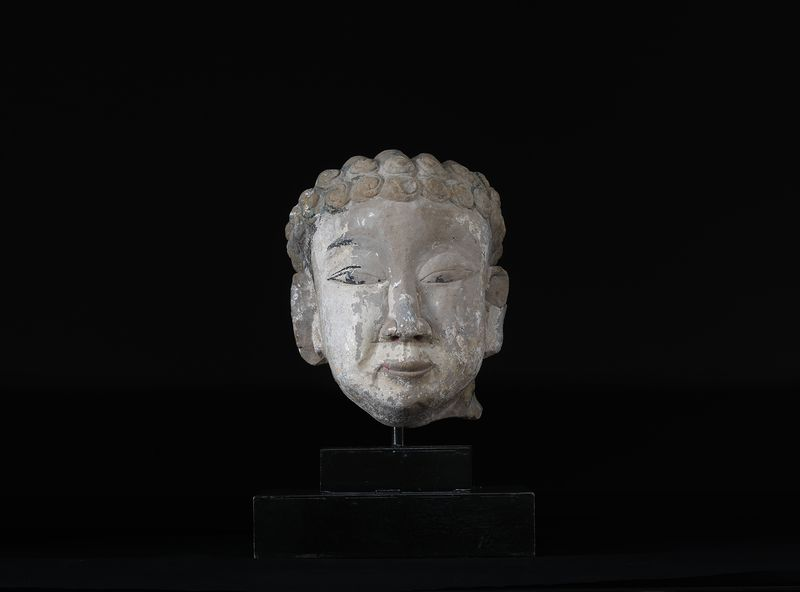Tête de Bouddha, Chine, entre 960 et 1279
Tête de Bouddha, Chine, entre 960 et 1279. Photo KOHN
Pierre. H. 48,3 cm. Estimation : 30 000 € / 40 000 €
STONE HEAD OF BUDDHA, China, Circa: 960 to 1279
Stone. Dimension: 19’’ high
After the collapse of the Tang Dynasty (906 AD), there was a succession of short-lived governments (known as the Five Dynasties). This period of unrest came to an end with the establishment of the Northern Song Dynasty in 960 AD. Renewed political stability helped to usher in a period of economic prosperity and a massive rise in population. Amongst the many cultural achievements of the Song Dynasty, the re- invigoration of the examination system and the invention of movable type rank highly. Intellectually the greatest achievement was the development of Neo-Confucianism- a philosophical movement heavily influenced by Buddhist teachings.
Although Buddhism had reached China from India during the Han Dynasty, it took time for the new faith to make progress. This was partly because it had to compete with native ideologies, namely Confucianism and Daoism. It was possible, however, to find common ground between these belief systems and by the Tang Dynasty Buddhism was experiencing a golden age in China. his head of Buddha is an exquisite example of the trend toward simplistic renderings of Buddhist images as a result of the expansion of Ch’an school teachings during the Sung period. The face is rounded and carved with a sense of fluidity as the facial expressions convey the blissful, serene sensation of enlightenment. The lips of the mouth are upturned, giving the impression of a «smiling Buddha,» and the eyes are half closed in meditation, accentuating the Buddha’s transcendence of all states of existence. Elegantly arched eyebrows and the delicately sculpted nose create a fluid line that extends beyond both corners of the mouth to the undefined area of the chin, giving the face a rather supple feel. The hair is twisted into tight curls incised with spirals forming an usnisa, a swelling on the top of the head signifying the Buddha’s enlightenment. Though the swelling is usually covered with hair, in this image, it is bare, boldly protruding from the summit of the head. The pendant earlobes curve upward at the tips, unadorned and rounded. Buddhist sculpture of the Sung period is characterized by sentimentalism, expressed through the grace and feminine refinements of the features. This sculpture captures the artistic as well as spiritual sentiments of the period.
KOHN. Collection Fayez Barakat, Antiques, Art Islamique, Art Précolombien ..., le 23 Juin 2014 à 17h. HÔTEL LE BRISTOL – SALON CASTELLANE, 112 RUE DU FAUBOURG SAINT HONORÉ – 75008 PARIS. Tel: +33 (0) 1 44 18 73 00.

/https%3A%2F%2Fprofilepics.canalblog.com%2Fprofilepics%2F1%2F0%2F100183.jpg)
/https%3A%2F%2Fstorage.canalblog.com%2F03%2F02%2F119589%2F96711876_o.jpg)
/https%3A%2F%2Fstorage.canalblog.com%2F11%2F31%2F119589%2F94773502_o.jpg)
/https%3A%2F%2Fstorage.canalblog.com%2F20%2F83%2F119589%2F94772815_o.jpg)
/https%3A%2F%2Fstorage.canalblog.com%2F26%2F72%2F119589%2F75604929_o.jpg)
/https%3A%2F%2Fstorage.canalblog.com%2F59%2F60%2F119589%2F26458628_o.jpg)




/http%3A%2F%2Fstorage.canalblog.com%2F63%2F11%2F119589%2F128988130_o.jpg)
/http%3A%2F%2Fstorage.canalblog.com%2F43%2F38%2F119589%2F128988081_o.jpg)
/http%3A%2F%2Fstorage.canalblog.com%2F69%2F39%2F119589%2F128988006_o.jpg)
/http%3A%2F%2Fstorage.canalblog.com%2F31%2F63%2F119589%2F128981265_o.jpg)